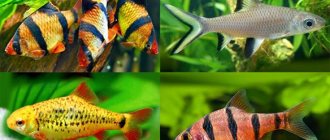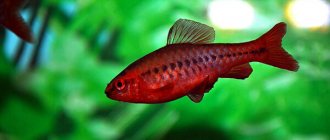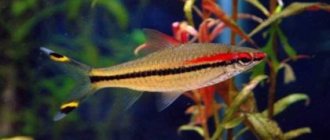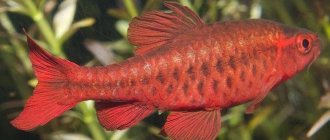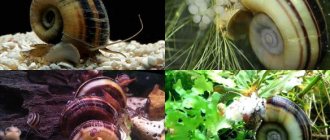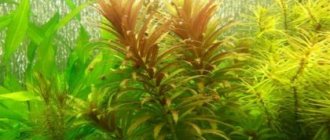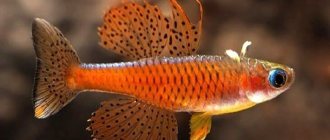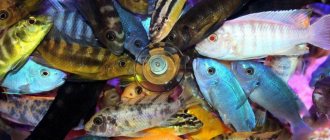Description and general information
The fire barb or fire puntius is an independent species of ray-finned fish of the famous cyprinid family. A mobile, schooling representative of the middle and lower layers of freshwater bodies. In nature, individuals of the “flaming” variety grow up to 15 cm in length, but in captivity the size of fish rarely reaches 10 cm.
The fiery puntius was the first barb to be bred in aquariums.
The fire barb is a spectacular aquarium fish with a bright color
Appearance
A distinctive feature of the fiery puntius is its rich body color, cast in golden and scarlet tones.
Description of appearance:
- The body is torpedo-shaped, slightly flattened laterally.
- One dorsal fin is a characteristic feature of the family.
- The tail is forked at the end, which gives the fish the opportunity to develop speed and quickly maneuver in the water.
- There is a small irregularly shaped black spot on the caudal peduncle. These dark pigmented scales are a distinctive feature of the breed.
- There are no antennae.
The color of males is more pronounced than that of females. In females, body color varies in silver-emerald shades.
Spreading
- The main habitat of these bright fish is India. The fire barb can be found in reservoirs located in the states of Assam and Bengal. The fire barb can also be found in the waters of Australia, Singapore, Colombia and Mexico.
- It is noteworthy that depending on the habitat, different individuals exhibit differences in appearance. For example, by the brightness of the colors. In nature, the fire barb is found both in lakes or rivers with fast currents, and in ponds or swamps.
Subspecies
Aquarists owe the intraspecific diversity of fiery puntius to selection.
The taxonomic category is represented by fiery barb:
- ordinary;
- veiled;
- neon.
The basic structural unit and its derivatives have slight differences in color and fins. The photo and table below show a comparative description of intraspecific differences in fire barbs.
| Main color | copper | red gold | from copper to scarlet-gold |
| Back color | golden olive | copper gold | from copper-gold to anthracite |
| Tail fin | body tone | body tone | light or transparent sometimes with black edging |
| Dorsal | red with black top | red with black top | from colorless with white or dark edging to black |
| Pectoral fin | colorless or light scarlet | colorless or light scarlet | colorless with white or black edging |
| Pelvic and anal fin | light scarlet with black edging | light scarlet with black edging | colorless with white or black edging |
Fiery (regular)
Fiery is an independent species of barb. The body color is scarlet-golden with a slight green tint on the back. The fins are copper-red with black tips.
Fish with a reddish-golden body color, the tail has a color ranging from sunny yellow to scarlet
Fiery veil
A beautiful subspecies of the common fire barb. The body color is golden-red, the back and head have a greenish tint. The fins are elongated, lighter than the body. The dorsal fin has a black tip, the rest have a colorless or dark edge.
Externally, the veiled barb is clearly distinguishable from other representatives of the species. But these fish must be handled carefully, as they can easily injure their lush fins.
A fish with elongated fins forming a long, spectacular veil
Fire neon
The second subspecies of the common fiery barb is a bright fish with a richer body color and a golden sheen.
The lightest variety of fire barb
What does he like to eat?
Like all representatives of cyprinids, preference is given to animal food: bloodworms, tubifex, coretra, cyclops, daphnia. You can also feed it with frozen minced meat or fish, or shrimp gruel. Reasonable alternation of such components with plant foods will give the fish the necessary boost of vigor and energy. You can finely grind fresh cucumber, zucchini, spinach, or grind several components into a total mass.
To make this food soft, you can first freeze it or scald it with boiling water.
For extreme cases, dry food is also suitable, especially in the form of plates with a combined balanced composition of vitamins and minerals.
Content
When keeping a fire barb, you should take into account the character and needs of the fish - nimble and mobile, similar to flames in an aquarium, punts are prone to play pranks.
For the peace and comfort of pets, shelters and grottoes are located in the aquarium so that the fish can hide if they wish. Caves are especially important when keeping barbs together in a multi-species aquarium, since the former are sometimes too energetic.
Who do firefish get along with?
A flock of puntius is interesting in itself, and individuals can be kept separately without adding other inhabitants. But if barbs are supposed to be placed in a common tank, then they can get along with many creatures. Although everything is individual here:
- some representatives of the species have bad habits and can cause mischief by tearing off the fins of other fish, slower ones - angelfish, veiltails, etc.;
- Puntius neighbors should also love a cool water environment - these could be cardinals, panda catfish.
Compatibility
Experienced aquarists prefer to keep fire barbs separately. Due to their mobility and mischief, the fish often pluck the long fins of their neighbors.
If it is impossible to allocate a separate aquarium for fish, then good neighbors for puntius would be:
- Peaceful catfish: Ancistrus, Thorakatum, Corydoras.
- Danios, irises, other species of barbs and rasboras.
- Platies, thornets, mollies.
- Tetras, swordtails, parrots.
Acaras, astronotuses and other large predatory species pose a danger to barbs.
If there are different compatible species in the aquarium, the contents should meet the needs of all representatives.
Reproduction and breeding
Breeding fire barbs is not difficult. Offspring are obtained naturally, but only from young sires. After 3-4 years, the fish no longer go to spawn.
The color of the male becomes more saturated during the spawning period. He begins his “ritual dance” in front of the female when her abdomen is filled with eggs. The spawning process of barbs will be discussed in detail below.
Sex differences
The easiest time to determine the sex of fish is during spawning. Barbs reach sexual maturity at 8 months. At this time, individuals already reach 6 cm in length.
You can distinguish male representatives from female ones by the following characteristics:
- Females are larger, more plump and wider than males.
- In terms of color, the male fire barb is juicier and richer, while the girls are more modestly colored - more faded.
A week before spawning, future breeders are switched to increased nutrition with live food.
The color of males becomes more colorful before spawning
Requirements for the spawning tank
In fire barbs, spawning occurs in a separate tank, so for reproduction you need to equip a container with a capacity of 30 liters. Its bottom is lined with Java moss or large mesh to preserve the eggs.
Water is poured into the spawning tank at a level of 15 cm and raised a couple of degrees to 25-26˚C. Lighting for breeding is set to dim.
Spawning
One male and two females are placed in the spawning tank, choosing the most active and colorful fish.
Reproduction of fire barbs is carried out as follows:
- Spawning begins with the throwing of eggs, which the female lays on plants and substrate.
- The male, immediately following the female, fertilizes the eggs.
- After spawning is completed, the parents are returned to the previous aquarium, otherwise the puntius will eat the eggs.
- In the spawning tank, perform a 50% water change and reduce the lighting intensity.
If the spawning was successful, then after a day or two, larvae appear from the eggs, which after 3 days transform into fry. They begin to swim and feed on living dust and ciliates.
Growing small barb fish is not difficult and interesting. As adolescents grow older, they are introduced to the diet of brine shrimp, yolk mashed with water, and nauplii.
The spawning ground, and subsequently the incubator, at all stages must be provided with good aeration and filtration.
The pair needs to be separated for several weeks, introducing more high-protein feed into the diet
Reproduction
Provoking a fire barb to reproduce is not difficult. Once the fish reaches six centimeters in length, it becomes ready to mate. It is best to create a pair from individuals belonging to the same flock, distinguished by the brightest and most beautiful colors.
During spawning, the female does not choose a specific place to lay eggs; she lays them throughout the aquarium, and they, in turn, independently stick to walls, stones, plants and snags. Then it’s the male’s turn to contribute to the creation of offspring - he fertilizes the eggs. For spawning, fish should be placed in a separate aquarium, and immediately after fertilization of the eggs, returned back to the school, since this species tends to eat its eggs.
About a day after laying, the eggs hatch into larvae. Within three days they transform into fry. From this moment on, small future fish need food. To feed the fry they usually use:
- Microworms.
- Ciliates.
- Egg yolk.
Diseases
Barbs are not prone to any specific diseases and have strong immunity. Pathological conditions in fish mainly develop due to errors in maintenance. Sick individuals are always isolated for the period of treatment to prevent the spread of pathology.
Ammonia poisoning
An overcrowded aquarium, irregular water changes, insufficient operation of the filter and aeration equipment provoke ammonia poisoning in fish. It is manifested by increased swallowing of air, fish living near the surface, and redness of the gills. When negative factors are eliminated, the condition of the barbs will stabilize without treatment.
Camallanides
An invasive disease caused by helminths. Infection occurs through live food of river origin. The fish loses its appetite and is apathetic. Upon observation, parasites protruding from the anus are noticeable. Treated with antihelminthics (Fenbendazole). The drug is added according to the instructions into the feed or into a feeding container for therapeutic effects.
Poisoning occurs due to infrequent water changes and overcrowding
Dropsy
The disease is difficult to treat and can be caused by a number of factors:
- prolonged detention in unfavorable conditions (dirty water, sudden temperature changes, insufficient aeration);
- viral, parasitic, infectious lesions.
The symptoms of dropsy are as follows:
- the fish swims near the surface, often swallowing air;
- mucus in excrement;
- strong uniform bloating of the abdomen;
- raised faded scales.
The disease is curable only at an early stage - when mucus appears in the excrement. Therapy begins with a salt bath (1-2 teaspoons of magnesium sulfate per 40 liters of water) and antibacterial drugs - tetracycline or chloromycetin (administered through food or in baths).
Ichthyophthiriasis
A contagious disease caused by protozoa parasitizing fish. It manifests itself in the formation of white dots on the integumentary tissues and fins of barbs. Often introduced into aquariums with new inhabitants.
It is treated in the following ways:
- table salt solution;
- special preparations that are sold in pet stores;
- formaldehyde, potassium permanganate or copper sulfate.
Therapy is carried out against the background of increased (by several degrees) temperature in the aquarium and increased aeration. Only floating forms of parasites fall within the spectrum of action of the drug; the drugs do not act on cysts and trophonts located under the epithelium.
Dropsy is characterized by an enlarged abdomen
Fin rot
A bacterial disease introduced into the aquarium with food, plants, or new animals. The bacteria affect fish with weakened immune systems. They appear as a white coating on the fish in the aquarium, an uneven edge of the fin, and fading of the color of the organ. As the disease worsens, erosions develop, which leads to tissue breakdown.
The disease is treated with table salt, potassium permanganate, bacteriostatic antibiotics (chloramphenicol, tetracycline) until the blood vessels and muscles are affected.
Oxygen starvation
Insufficient aeration against the background of increased water temperature in the aquarium can provoke oxygen starvation in barbs. Fish are very sensitive to oxygen deficiency. In such an environment, they will always swim near the surface and often swallow atmospheric air. Replacing water, smoothly cooling it to normal and good aeration eliminate the symptoms of hypoxia without treatment.
With fin rot, the fins are damaged and in the final stages are completely destroyed
Price
You can purchase fire barbs in specialized stores, markets, and online on online trading platforms. The cost of aquarium fish varies everywhere and depends on the species shape, the size of the barbs, the quantity purchased and the pricing policy of the seller.
| Average cost, in rubles | |||
| Size, cm | 2-2,5 | 3,5-4 | 5-6 |
| 50-85 | 85-170 | 140-200 | |
| 50-220 | 150-250 | 350 | |
| to order from 460 | |||
When purchasing fish remotely, the buyer always runs the risk of receiving unhealthy fish, since not all animals can survive transportation.
The average price of a fire barb is 140–350 rubles
Feeding rules
Golden barbs are unpretentious in food. They can be fed live or artificial food. In order for the fish’s immunity to be strong, the diet must be varied (for example, dry vegetable flakes + bloodworms or tubifex). In addition, some Puntius owners feed their pets with chopped greens (lettuce, cabbage, etc.). More inventive aquarists create special recipes based on the preferences of their fish.
1. Dried daphnia, gamarus for scent. 2. Fish meat (cod or some inexpensive white fish, shrimp). 3. Red bell pepper. 4. Carrots. 5. A drop of harvest bread. 6. Dried crushed seaweed (hornwort). 7. Boiled egg. I grind all this in different proportions to a fine dough-like mass, put it in a plastic bag and roll it out in a layer of 2-4 mm, freeze it.
Alexander, Omsk
https://www.aqa.ru/forum/farsh-dlya-barbusov-i-skalyariy-206719-page2
Adviсe
Each type of fish has its own characteristics of care, which are important to take into account to ensure aquarium inhabitants have a healthy and comfortable life in captivity.
Tips for successfully keeping and breeding fire barbs:
- To eliminate biological load in the home ecosystem, you need to correctly calculate the volume of the aquarium. To maintain one adult puntius you need at least 10 liters of water. A flock of 6 fish will require a tank with a volume of 50 liters.
- It is necessary to prevent an increase in the concentration of harmful compounds in water - ammonia, nitrates, nitrites, phosphates. Drip test systems, regular water changes, sufficient aeration and filtration will prevent the risk of toxic poisoning.
- It is better to not just settle the water for replacement, but to clean it with special conditioners, for example: Tetra AquaSafe, Aquacons “Instant Protection”, aquarium water conditioner “Formamed” and others. They not only destroy chlorine compounds and neutralize heavy metals, but also enrich the water with vitamins, macro- and microelements.
- If fish begin to overeat aquaculture, it means they are experiencing a shortage of plant food. It is necessary to slightly reduce the proportion of protein in the diet in favor of fiber.
- Once a week, barbs need to have a fasting day to reduce the likelihood of developing obesity, which in turn leads to premature death.
- It is better to start fish in a small flock of 6-8 individuals. In the company of relatives, barbs feel more comfortable and are less aggressive towards their neighbors.
- If breeding is planned, it is recommended to keep the fish at minimum temperatures. In such an environment, fire barbs go to spawn faster when the water temperature rises to stimulate the spawners.
In an aquarium with a dark background, fish with bright golden colors look especially impressive.
The more the environment resembles its natural habitat, the less stress the fish will experience.
Maintenance and care
The fire barb is an active, hardy fish with low requirements for living conditions. It is often recommended to beginners, including as a bright living decoration for an aquarium. Externally, this type of barb resembles a goldfish. However, unlike the latter, it behaves more actively in the aquarium. This must be taken into account when choosing potential neighbors for Barbus conchonius.
In nature, the fire barb prefers a gregarious lifestyle. For this reason, the aquarist needs to place a group of 8-10 fish in the aquarium at once. Otherwise, even such a peaceful aquatic organism begins to show aggression.
To keep a group of fire barbs you will need an aquarium with a capacity of 80-100 liters. The container must have a lid. Due to its activity, the fish may jump out of the container.
When decorating an aquarium, it is recommended to use natural landscaping. It wouldn’t hurt to add stones and driftwood. However, you should not take up too much space with the design composition - Barbus conchonius should be left with space for free swimming.
Water parameters for ideal maintenance
One of the features of the fire barb is its low water temperature requirements. An aquarium with these aquatic organisms does not require a thermostat, since the fish prefer to be in cool liquid. Experienced owners note that in summer, on the contrary, they have to solve the issue of water cooling.
To make the fish feel comfortable, it is recommended to maintain the following parameters of the aquarium fluid:
- temperature - 16-26ºС;
- hardness - 8-18º;
- acid-base balance - 6.5-7.5.
Every week it is necessary to change a third of the total volume of water. Barbus conchonius is sensitive to pollution and oxygen levels. For this reason, you will need to install a powerful filter and aerator.
Requirements for lighting and landscaping
Barbus conchonius requires diffused light of low to moderate brightness.
Experienced fish owners recommend shading the back wall of the vessel when decorating an aquarium. In this case, the barb will look very advantageous and shimmer with fiery flashes of scales.
This requirement imposes a certain limitation on the choice of aquarium plants that are vital for the barb. They will create hiding places for fish. Additionally, it is worth placing floating plants on the surface of the water to create a diffused light flux. For these purposes, for example, riccia or pistia are suitable.
What to feed a fire barb
The fire barb must be fed both protein and plant foods. The main rule is that food should be balanced, nutritious and varied. If the diet of Barbus conchonius does not have enough plant components, it begins to eat aquarium plants.
It is advisable to alternate feeding dry and live food as often as possible, avoiding monotony.
Invertebrates that form the basis of the diet of these fish in nature can be used as live food for the fire barb:
- worms;
- shellfish;
- insect larvae.
When choosing specialized dry food, you should pay attention to such products as:
TetraPro Color food in the form of chips, which helps maintain the bright colors of aquarium pets;
TetraMin universal food with vitamins, minerals and prebiotics;
Tetra Phyll plant food;
TetraPro Algae is another product enriched with herbal ingredients;
Tetra FreshDelica special treats for fish based on bloodworms, daphnia or brine shrimp;
Sera Viformo fish food with herbal ingredients for various types of fish, including barbs.
Experts recommend feeding your fire barb several times a day in small portions that can be consumed in a few minutes. These fish are prone to overeating. It is advisable to limit them in food once a week to maintain healthy digestion.
Interesting Facts
The fire barb was first described by the Scottish naturalist Francis Hamilton in 1822. But these fish came to Europe from India only 80 years later, in 1903. For Soviet aquarists, the species became available for breeding in the 20s of the 20th century. Since then, fiery puntius has often been used for ichthyological research and in genetic engineering. The first breeding varieties were obtained from the common fiery barb.
In the process of keeping fire barbs, many interesting facts were noticed about the life of these inhabitants in the aquarium:
- moderate current perfectly stimulates the color of fish;
- easily tolerate low physical parameters of the environment and feel good even at a water temperature of 15˚C;
- when kept alone (outside the flock), the puntius's aggression increases;
- males love to demonstrate their stature and beauty to their own kind. They spend most of their time in such company and ignore females;
- can interbreed with other closely related species of barbs: scarlet, scarlet and black. But the last representative of the family produces infertile offspring.
With age, the metabolism of barbs decreases and the fish become prone to gaining excess weight. But the color intensity increases towards the end of life. The golden scales of aging individuals acquire a bright red-orange tint.
Description of the fire barb
It is often called red or pink because of its color. It is considered one of the brightest and most beautiful barbs in the genus. It has shiny golden scales, thanks to which schools of scurrying fish look extremely impressive.
Appearance
Characteristics of the breed are one dorsal fin and a black mark on the caudal peduncle. Males have a greenish tint on their backs.
Features of the appearance of fire barbs:
- the body is torpedo-shaped, slightly flattened laterally;
- head - pointed;
- tail - forked at the end;
- mustache - absent;
- color - from pale pink to bright orange;
- body length - up to 7 cm (in nature they reach 10-15 cm);
- fins are red, often with a black border.
Thanks to their forked tail, fire barbs can reach high speeds and perform rapid maneuvers.
The fire barb was first discovered and described by Scottish naturalist Francis Hamilton in 1822, but this fish appeared in aquariums only at the beginning of the 20th century.
Features of behavior
Fire barbs are peaceful and hardy, making them ideal for aquarists of all skill levels. These fish have a very low level of aggression.
For example, compared to mossy barbs, known for their complex personalities, the fiery species is simply quiet. Their aggression level is no more than 30%.
Fire barbs, unlike most of their counterparts, live in cooler water - from +18...+22 °C. They prefer quiet bodies of water with plenty of natural cover. In nature, these fish hunt insects, larvae, and actively eat plant food.
Lifespan
The lifespan of fire barbs, like other species of fish, depends on the conditions of detention. The cleaner the water, and the conditions as close to ideal as possible, the longer the barbs live. On average, fire barbs live and remain active for about 5 years.
To prevent barbs from losing their activity, at the age of two years they are placed with a flock of young relatives.
Experienced aquarists advise rejuvenating the population every 3 years, since the physical activity of fish decreases with age. After 4 years of life, fire barbs lose the ability to reproduce.
As they grow older, barbs can gain excess weight, which also negatively affects their life expectancy and sexual activity. But with age, barbs acquire especially bright colors.
Habitat in the wild
The fire barb is found in water bodies of East and South Asia - India, Bengal, Bangladesh. The fish is also found in Nepal, Pakistan, and Afghanistan. This fish also lives in reservoirs where it was introduced artificially. Now its habitat includes Australia, Mexico, Colombia, Puerto Rico, and Singapore.
The fish adapts well to different conditions. Barbs feel most comfortable in stagnant waters. But they are also found in fast-flowing streams and rivers.
Habitat can affect the appearance of fire barbs (color). The brightest fish live in the waters of Bengal.
Differences between subspecies
There are three subspecies of fire barbs, which differ from each other in external characteristics. They all look very impressive in an aquarium, but some of them are more or less decorative fish.
Fire barbs are:
- Ordinary. The color of the scales is reddish-golden, and the color of the tail varies from yellow to scarlet. The back is golden with a green tint.
- Veiled. A distinctive feature of this subspecies is its spectacular veil-like fins. The scales of the fish are golden-red, and the tail is slightly paler, almost gray. All fins, except the dorsal, repeat the color of the body. Only the back of the fin is different - it is black. The back is also dark, with a green tint.
- Neon. This is the lightest subspecies of the fire barb. Only his back is painted red and gold. All fins are light golden. The scales are golden. There are patches of red throughout the body. The neon barb got its name for its characteristic exquisite shimmer.
The main differences between the subspecies of fire barbs:
| Signs | Fire neon | Fiery veil | fiery gold |
| Scale color | Yellowish-gold with red flecks | Reddish-golden | Golden red |
| Tail | Yellowish-golden | Gold with colorless border | From red to golden |
| Dorsal fin | Golden | Black | Red with black border |
| Pectoral fins | Golden | Red-golden | Reds |
| Back color | Golden red | Black with green tint | Golden with green tint |
Reviews
Fire barbs are active and nimble fish, which are a lot of fun to watch in an aquarium. Despite their excessive energy, in general, puntius are friendly and unpretentious, so even novice aquarists can keep fish.
Already have experience keeping fire barbs? Share in the comments!
Description
The firefish lives in rivers and lakes of India, Australia and New Zealand. The veil and neon forms of the fiery barb have been artificially bred. Subspecies are able to interbreed and produce offspring.
Appearance
The oblong body of the barb is pale gold to red in color. It grows up to 10 cm. The scales shimmer in the light, resembling a flame in appearance. The back is greenish, the belly of males is red, the fins are translucent with a dark edging. There is a dark dot near the tail.
Behavior
Puntiuses cannot be called harmless. Fire barbs bite the veil and filament fins of other aquarium fish. Barbs are active and cheerful. They feel good in a flock of 6 or more individuals.
Lifespan
The fiery inhabitants of the aquarium live up to 5 years.
